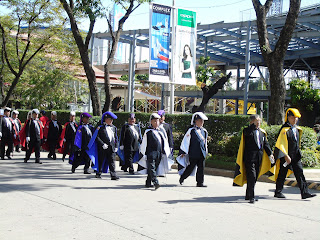 |
| left: a color corps member with full regalia. right: a knight wearing the new fourth degree uniform. Photos from Columbia Magazine |
The Board of Directors of the Supreme Council in the United States has decided to replace the uniform of the fourth degree knights consisting of tuxedo, black trousers and bow tie with blue blazer, dark gray slacks, tie and beret. It has also done away with the regalia that has usually been long associated with the Knights of Columbus such as the chapeau and cape that are worn by the color corps, the faithful navigator, the district marshal and some officers of the Supreme Council. The baldric is kept as part of the uniform. With the beret, the new uniform looks militaristic which to my view is in line with the fourth degree principle of patriotism.
 |
| Knights of Columbus Fourth Degree Uniform |
In the Philippines, due to the hot climate, the fourth degree knights have been adopting the long-sleeved white shirt in lieu of the tuxedo as their uniform. A coat is most often a formal indoor attire inside an air conditioned room or building. The new Supreme Council directive will mostly affect members of the color corps since it is this group that wear the uniform and the regalia that are prescribed by the US based Supreme Council.
The color corps is the most visible arm of the order. Its members participate in activities such as independence day, charter day and other civic occasions. They also do duty during necrological services to the departed fourth degree knights, in the installation of new fourth degree members and officers and in church activities such as liturgical processions.
Some fourth degree knights especially those in the US express opposition to the introduction of the new uniform for one reason or another. And they have valid views for their complaints such as the discarding of the traditional and well liked regalia and the cost of having the new uniform. The new uniform can be ordered online at knightsgear.com. But buying it from a US based online store will be very expensive for a Filipino fourth degree knight considering the exchange rate between the US dollar and the Philippine peso. If they could have the blazer, the slacks and the patches source or made locally instead of ordering them from the US, then they could have those items at a fraction of the cost of the imported ones.
The policy of the new uniform is somewhat a divisive and contentious issue to the Fourth degree Knight of Columbus members. And I agree with some of the issues raised by those who do not like the new uniform. It is my opinion though that fourth degree knights should adhere to the decision of the Supreme Council for the sake of unity and good of the order irrespective of their individual and personal preference with regard to the matter.
























































